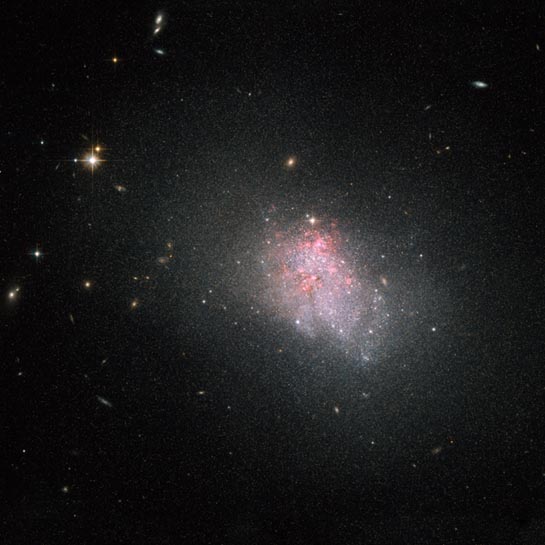
in Dwarf Galaxies
Dwarf galaxy
RA 11h 35m 47.83s Dec 54° 31' 49.09"
Ursa Major
12 million light years
11.7
2.5 x 1.9 arcmin
3.33 x 3.14 arcminutes
North is 78.1° left of vertical
ESA/Hubble & NASA
October 22, 2012
ABOUT
THIS IMAGE:
The NASA/ESA Hubble Space Telescope has imaged the faint irregular galaxy NGC 3738, a starburst galaxy. The galaxy is in the midst of a violent episode of star formation, during which it is converting reservoirs of hydrogen gas tucked away in the galaxy's center into stars. Hubble spots this gas glowing red around NGC 3738, one of the most distinctive signs of ongoing star formation.
Lying in the constellation of Ursa Major (The Great Bear), NGC 3738 is located about 12 million light-years from the Sun, and belongs to the Messier 81 group of galaxies. This galaxy - first observed by astronomer William Herschel back in April 14, 1789 - is a nearby example of a blue compact dwarf, the faintest type of starburst galaxy. Blue compact dwarfs are small compared to large spiral galaxies - NGC 3738 is around 10,000 light-years across, just one tenth of the size of the Milky Way.
This
type of galaxy is blue in appearance by virtue of containing large clusters
of hot, massive stars, which ionize the surrounding interstellar gas with
their intense ultraviolet radiation. They are relatively faint and appear
to be irregular in shape. Unlike spirals or elliptical galaxies, irregular
galaxies do not have any distinctive features, such as a nuclear bulge
or spiral arms. Rather, they are extremely chaotic in appearance. These
galaxies are thought to resemble some of the earliest that formed in the
Universe and may provide clues as to how stars appeared shortly after
the Big Bang.